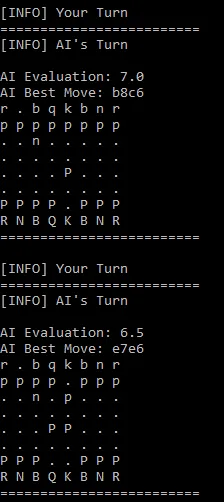动机:
我试图制作一个基本的AI代理程序,可以与对手下棋。目标是通过后续使用机器学习来看它能变得有多好,同时学习棋类游戏中我们玩游戏时无法了解的细节,如评估参数。
代码:
这是我目前为止拥有的东西:
import chess, chess.pgn, time, math, io
import numpy as np
from selenium import webdriver
from selenium.webdriver.common.keys import Keys
from selenium.webdriver.common.action_chains import ActionChains
from selenium.webdriver.support.ui import Select
piece_values = {'P': 10, 'N': 30, 'B': 30, 'R': 50, 'Q': 90, 'K': 100, 'p': -10, 'n': -30, 'b': -30, 'r': -50, 'q': -90, 'k': -100}
# These are all flipped
position_values = {
'P' : np.array([ [0.0, 0.0, 0.0, 0.0, 0.0, 0.0, 0.0, 0.0],
[5.0, 5.0, 5.0, 5.0, 5.0, 5.0, 5.0, 5.0],
[1.0, 1.0, 2.0, 3.0, 3.0, 2.0, 1.0, 1.0],
[0.5, 0.5, 1.0, 2.5, 2.5, 1.0, 0.5, 0.5],
[0.0, 0.0, 0.0, 2.0, 2.0, 0.0, 0.0, 0.0],
[0.5, -0.5, -1.0, 0.0, 0.0, -1.0, -0.5, 0.5],
[0.5, 1.0, 1.0, -2.0, -2.0, 1.0, 1.0, 0.5],
[0.0, 0.0, 0.0, 0.0, 0.0, 0.0, 0.0, 0.0] ]),
'N' : np.array([[-5.0, -4.0, -3.0, -3.0, -3.0, -3.0, -4.0, -5.0],
[-4.0, -2.0, 0.0, 0.0, 0.0, 0.0, -2.0, -4.0],
[-3.0, 0.0, 1.0, 1.5, 1.5, 1.0, 0.0, -3.0],
[-3.0, 0.5, 1.5, 2.0, 2.0, 1.5, 0.5, -3.0],
[-3.0, 0.0, 1.5, 2.0, 2.0, 1.5, 0.0, -3.0],
[-3.0, 0.5, 1.0, 1.5, 1.5, 1.0, 0.5, -3.0],
[-4.0, -2.0, 0.0, 0.5, 0.5, 0.0, -2.0, -4.0],
[-5.0, -4.0, -3.0, -3.0, -3.0, -3.0, -4.0, -5.0] ]),
'B' : np.array([[-2.0, -1.0, -1.0, -1.0, -1.0, -1.0, -1.0, -2.0],
[-1.0, 0.0, 0.0, 0.0, 0.0, 0.0, 0.0, -1.0],
[-1.0, 0.0, 0.5, 1.0, 1.0, 0.5, 0.0, -1.0],
[-1.0, 0.5, 0.5, 1.0, 1.0, 0.5, 0.5, -1.0],
[-1.0, 0.0, 1.0, 1.0, 1.0, 1.0, 0.0, -1.0],
[-1.0, 1.0, 1.0, 1.0, 1.0, 1.0, 1.0, -1.0],
[-1.0, 0.5, 0.0, 0.0, 0.0, 0.0, 0.5, -1.0],
[-2.0, -1.0, -1.0, -1.0, -1.0, -1.0, -1.0, -2.0] ]),
'R' : np.array([[ 0.0, 0.0, 0.0, 0.0, 0.0, 0.0, 0.0, 0.0],
[ 0.5, 1.0, 1.0, 1.0, 1.0, 1.0, 1.0, 0.5],
[-0.5, 0.0, 0.0, 0.0, 0.0, 0.0, 0.0, -0.5],
[-0.5, 0.0, 0.0, 0.0, 0.0, 0.0, 0.0, -0.5],
[-0.5, 0.0, 0.0, 0.0, 0.0, 0.0, 0.0, -0.5],
[-0.5, 0.0, 0.0, 0.0, 0.0, 0.0, 0.0, -0.5],
[-0.5, 0.0, 0.0, 0.0, 0.0, 0.0, 0.0, -0.5],
[ 0.0, 0.0, 0.0, 0.5, 0.5, 0.0, 0.0, 0.0]]),
'Q' : np.array([[-2.0, -1.0, -1.0, -0.5, -0.5, -1.0, -1.0, -2.0],
[-1.0, 0.0, 0.0, 0.0, 0.0, 0.0, 0.0, -1.0],
[-1.0, 0.0, 0.5, 0.5, 0.5, 0.5, 0.0, -1.0],
[-0.5, 0.0, 0.5, 0.5, 0.5, 0.5, 0.0, -0.5],
[-0.5, 0.0, 0.5, 0.5, 0.5, 0.5, 0.0, -0.5],
[-1.0, 0.5, 0.5, 0.5, 0.5, 0.5, 0.0, -1.0],
[-1.0, 0.0, 0.5, 0.0, 0.0, 0.0, 0.0, -1.0],
[-2.0, -1.0, -1.0, -0.5, -0.5, -1.0, -1.0, -2.0]]),
'K' : np.array([[ -3.0, -4.0, -4.0, -5.0, -5.0, -4.0, -4.0, -3.0],
[ -3.0, -4.0, -4.0, -5.0, -5.0, -4.0, -4.0, -3.0],
[ -3.0, -4.0, -4.0, -5.0, -5.0, -4.0, -4.0, -3.0],
[ -3.0, -4.0, -4.0, -5.0, -5.0, -4.0, -4.0, -3.0],
[ -2.0, -3.0, -3.0, -4.0, -4.0, -3.0, -3.0, -2.0],
[ -1.0, -2.0, -2.0, -2.0, -2.0, -2.0, -2.0, -1.0],
[ 2.0, 2.0, 0.0, 0.0, 0.0, 0.0, 2.0, 2.0 ],
[ 2.0, 3.0, 1.0, 0.0, 0.0, 1.0, 3.0, 2.0 ]])}
class LichessBot:
def __init__(self, fen):
self.fen = fen
self.bot = webdriver.Firefox(executable_path=r'geckodriver.exe')
def initialize(self):
bot = self.bot
bot.get('https://lichess.org/editor/rnbqkbnr/pppppppp/8/8/8/8/PPPPPPPP/RNBQKBNR_w_KQkq_-')
time.sleep(3)
analysis = bot.find_element_by_css_selector(".actions > a:nth-child(2)").click()
time.sleep(1)
def gameSelect(self, fen):
bot = self.bot
fen_area = bot.find_element_by_class_name("analyse__underboard__fen")
bot.execute_script('arguments[0].setAttribute("value", arguments[1]);', fen_area, fen)
# Refresh the page to enter new fen number properly every time
fen_new = bot.find_element_by_class_name("analyse__underboard__fen").get_attribute('value').replace(' ', '_')
bot.get('https://lichess.org/analysis/standard/{}'.format(fen_new))
def gameReturn(self):
bot = self.bot
fen_return = bot.find_element_by_class_name("analyse__underboard__fen").get_attribute('value')
time.sleep(1)
return fen_return
def positionEvaluation(position, piece_values=piece_values, position_values=position_values):
# Position of pieces is not taken into account for their strength
if position_values == 'None':
total_eval = 0
pieces = list(position.piece_map().values())
for piece in pieces:
total_eval += piece_values[str(piece)]
return total_eval
else:
positionTotalEval = 0
pieces = position.piece_map()
for j in pieces:
file = chess.square_file(j)
rank = chess.square_rank(j)
piece_type = str(pieces[j])
positionArray = position_values[piece_type.upper()]
if piece_type.isupper():
flippedPositionArray = np.flip(positionArray, axis=0)
positionTotalEval += piece_values[piece_type] + flippedPositionArray[rank, file]
else:
positionTotalEval += piece_values[piece_type] - positionArray[rank, file]
return positionTotalEval
def minimax(position, depth, alpha, beta, maximizingPlayer, bestMove = 'h1h3'):
if depth == 0 or position.is_game_over():
return positionEvaluation(position, piece_values, position_values), bestMove
if maximizingPlayer:
maxEval = -np.inf
for child in [str(i).replace("Move.from_uci(\'", '').replace('\')', '') for i in list(position.legal_moves)]:
position.push(chess.Move.from_uci(child))
eval_position = minimax(position, depth-1, alpha, beta, False)[0]
position.pop()
maxEval = np.maximum(maxEval, eval_position)
alpha = np.maximum(alpha, eval_position)
if beta <= alpha:
break
return maxEval
else:
minEval = np.inf
minMove = np.inf
for child in [str(i).replace("Move.from_uci(\'", '').replace('\')', '') for i in list(position.legal_moves)]:
position.push(chess.Move.from_uci(child))
eval_position = minimax(position, depth-1, alpha, beta, True)
position.pop()
minEval = np.minimum(minEval, eval_position)
if minEval < minMove:
minMove = minEval
bestMin = child
beta = np.minimum(beta, eval_position)
if beta <= alpha:
break
return minEval, bestMin
# # To check evaluation
# board = chess.Board()
# print(positionEvaluation(board))
# quit()
# Initialize and set up position
lichess = LichessBot('rnbqkbnr/pppppppp/8/8/8/8/PPPPPPPP/RNBQKBNR w KQkq -')
lichess.initialize()
board = chess.Board()
fen = board.fen()
lichess.gameSelect(fen)
while not board.is_game_over():
if board.turn == True:
print('\n[INFO] Your Turn\n=========================')
fen_new = fen
while fen_new == fen:
fen_new = lichess.gameReturn()
board = chess.Board(fen_new)
else:
print('[INFO] AI\'s Turn\n')
minimaxEval, bestMove = minimax(board, 4, -np.inf, np.inf, False)
print("AI Evaluation: {}\nAI Best Move: {}".format(minimaxEval, bestMove))
board.push(chess.Move.from_uci(bestMove))
print("{}\n=========================".format(board))
fen = board.fen()
lichess.gameSelect(fen)
以下是代码的功能:
打开Firefox终端并进入lichess.org网站
进入起始棋局分析模式
等待对手走一步棋
将FEN发送给Python程序以执行该步棋
应用最小化极大算法(minimax algorithm)来评估位置并决定最佳走法,同时考虑深度和位置值
在Python程序中执行此步棋
获取当前位置的FEN
通过将FEN粘贴到lichess上的分析棋盘中,下出最佳走法
问题:
目前这个程序只能让我执白子(计算机算法运行于黑方)。我的问题,虽然看起来很基础,但是如何使其在开始时可以选择哪一方?似乎最小化极大算法在计算机执黑时会有偏差,我尝试过调整但没有成功。
输出结果:
下面是游戏进行时在控制台上的典型输出。当游戏结束时不会发生任何特殊情况,我计划稍后包括一份游戏总结和结果。
可以看出,我通过在每次移动后在控制台输出当前棋盘状态来确保移动被正确注册。
最终说明:
我知道评估指标甚至算法的效率可能不是最好的,但是这些将在所有细节(例如问题中提到的细节)解决后进行调整。
